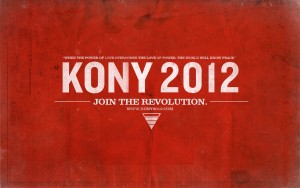Discussion post 1- (Invisible Children)
Kony 2012 was a movement that started with just a few individuals, and a dream. A video that portrayed the events surrounding Kony was posted on YouTube and was viewed, and as time went on it grew, and grew, and grew. This movement that brought about millions of aware citizens across the world achieved it’s goal of making the general public aware of the horrors happening in Uganda. The main platform in which this video spread was because of the wonderful tool we call the internet.
The spread of media on social media platforms where everyday people can get involved can be described as participatory culture. In my opinion this played a huge part in spreading the Kony video all over the world wide web. Anybody who had a connection to the internet during this time was able to spread this video. Whether it was through Facebook, Twitter, or Instagram, all of these social media sites played a big part in keeping everyone aware , and actively participating. This is how most people became aware; through social media and the internet, and being able to share it with others so that they too could get involved in the Kony 2012 movement.
As it pertains in the book, participatory media is where “fans and other consumers are invited to actively participate…who interact with each other” (Fuchs, pg. 54). As seen in the Kony 2012 video the director of the short film was hoping to get his message across by just simply sharing his video. That was done through social media where WE, (the main audience) was prompted to share this video with others, therefore participating in the main goal the director was seeking. As more and more people began to share this video and view it, the more people began to realize they needed to join this movement. The issues in which Fuchs addresses that new media misses, in my opinion is wrong. The internet is a vast place where, in this day in time, anything can be processed, looked up, or found out. In his argument where he believes that new media misses the political, political economic, and socio-cultural aspects; I believe it’s all in how you look at it, and how you choose to process new media. Everyone chooses a different way to interpret and understand the constant changes of new media around us. This is why Kony 2012 is a good way to show how these issues were tackled and and how it did involve everyone on a political and socio-cultural level.
The criticism in which this video received I believe was misplaced. This video which ultimately spread awareness to those who were unaware did make am amazingly good impact and turn out for the Kony 2012 movement. The main objective which was obtained created something so beautiful; different races and cultures around the world to stand up for the rights of those who couldn’t stand up for themselves. I believe the Kony 2012 movement showed us all what the power of an idea and the internet combined can do. Also, how it can ultimately be used, and turned into a positive impact that can shape society, and bring everyone together to achieve a common goal.
I personally believe that these new media movements, with the help of media itself definitely takes part in a new wave of activism and slacktivism. Although activism is nothing new to our eyes, the way that new media is incorporated in it helps progress this new form a lot faster. Slacktivism can almost be seen as the same; saying it’s taking the lazy way of fighting for something that you believe in. I believe this this can be seen both ways, but I would lean more towards it being false. The way that media is constantly changing and the amount of people that join the internet world wide shows that a message or idea can be spread faster over the internet, rather than by word of mouth. As the world constantly changes so does the technology and the people in it, and it’s all up to you whether you chose to follow with the new media wave.


Leave a Reply